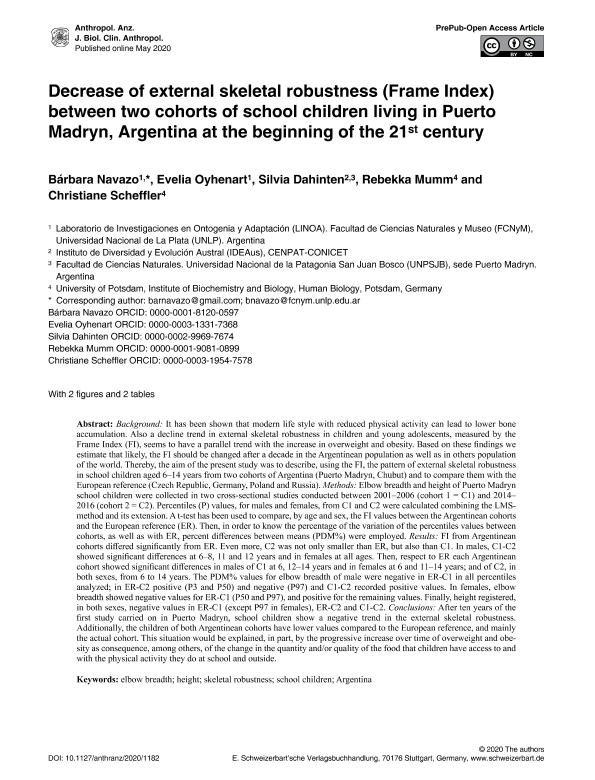Mostrar el registro sencillo del ítem
dc.contributor.author
Navazo, Bárbara

dc.contributor.author
Oyhenart, Evelia Edith

dc.contributor.author
Dahinten, Silvia Lucrecia V.

dc.contributor.author
Mumm, Rebekka
dc.contributor.author
Scheffler, Christiane
dc.date.available
2021-07-20T18:38:22Z
dc.date.issued
2020-08
dc.identifier.citation
Navazo, Bárbara; Oyhenart, Evelia Edith; Dahinten, Silvia Lucrecia V.; Mumm, Rebekka; Scheffler, Christiane; Decrease of external skeletal robustness (Frame index) between two cohorts of school children living in Puerto Madryn, Argentina at the beginning of the 21st century; Gebruder Borntraeger Verlagsbuchhandlung; Anthropologischer Anzeiger; 77; 5; 8-2020; 405-413
dc.identifier.uri
http://hdl.handle.net/11336/136530
dc.description.abstract
Background: It has been shown that modern life style with reduced physical activity can lead to lower bone accumulation. Also a decline trend in external skeletal robustness in children and young adolescents, measured by the Frame Index (FI), seems to have a parallel trend with the increase in overweight and obesity. Based on these findings we estimate that likely, the FI should be changed after a decade in the Argentinean population as well as in others population of the world. Thereby, the aim of the present study was to describe, using the FI, the pattern of external skeletal robustness in school children aged 6–14 years from two cohorts of Argentina (Puerto Madryn, Chubut) and to compare them with the European reference (Czech Republic, Germany, Poland and Russia). Methods: Elbow breadth and height of Puerto Madryn school children were collected in two cross-sectional studies conducted between 2001–2006 (cohort 1 = C1) and 2014– 2016 (cohort 2 = C2). Percentiles (P) values, for males and females, from C1 and C2 were calculated combining the LMS-method and its extension. A t-test has been used to compare, by age and sex, the FI values between the Argentinean cohorts and the European reference (ER). Then, in order to know the percentage of the variation of the percentiles values between cohorts, as well as with ER, percent differences between means (PDM%) were employed. Results: FI from Argentinean cohorts differed significantly from ER. Even more, C2 was not only smaller than ER, but also than C1. In males, C1-C2 showed significant differences at 6–8, 11 and 12 years and in females at all ages. Then, respect to ER each Argentinean cohort showed significant differences in males of C1 at 6, 12–14 years and in females at 6 and 11–14 years; and of C2, in both sexes, from 6 to 14 years. The PDM% values for elbow breadth of male were negative in ER-C1 in all percentiles analyzed; in ER-C2 positive (P3 and P50) and negative (P97) and C1-C2 recorded positive values. In females, elbow breadth showed negative values for ER-C1 (P50 and P97), and positive for the remaining values. Finally, height registered, in both sexes, negative values in ER-C1 (except P97 in females), ER-C2 and C1-C2. Conclusions: After ten years of the first study carried on in Puerto Madryn, school children show a negative trend in the external skeletal robustness. Additionally, the children of both Argentinean cohorts have lower values compared to the European reference, and mainly the actual cohort. This situation would be explained, in part, by the progressive increase over time of overweight and obesity as consequence, among others, of the change in the quantity and/or quality of the food that children have access to and with the physical activity they do at school and outside.
dc.format
application/pdf
dc.language.iso
eng
dc.publisher
Gebruder Borntraeger Verlagsbuchhandlung
dc.rights
info:eu-repo/semantics/openAccess
dc.rights.uri
https://creativecommons.org/licenses/by-nc/2.5/ar/
dc.subject
ARGENTINA
dc.subject
ELBOW BREADTH
dc.subject
HEIGHT
dc.subject
SCHOOL CHILDREN
dc.subject
SKELETAL ROBUSTNESS
dc.subject.classification
Salud Pública y Medioambiental

dc.subject.classification
Ciencias de la Salud

dc.subject.classification
CIENCIAS MÉDICAS Y DE LA SALUD

dc.title
Decrease of external skeletal robustness (Frame index) between two cohorts of school children living in Puerto Madryn, Argentina at the beginning of the 21st century
dc.type
info:eu-repo/semantics/article
dc.type
info:ar-repo/semantics/artículo
dc.type
info:eu-repo/semantics/publishedVersion
dc.date.updated
2021-07-15T12:25:53Z
dc.identifier.eissn
2363-7099
dc.journal.volume
77
dc.journal.number
5
dc.journal.pagination
405-413
dc.journal.pais
Alemania

dc.journal.ciudad
Stuttgart
dc.description.fil
Fil: Navazo, Bárbara. Universidad Nacional de La Plata. Facultad de Ciencias Naturales y Museo. Laboratorio de Investigaciones en Ontogenia y Adaptación; Argentina. Consejo Nacional de Investigaciones Científicas y Técnicas. Centro Científico Tecnológico Conicet - La Plata; Argentina
dc.description.fil
Fil: Oyhenart, Evelia Edith. Universidad Nacional de La Plata. Facultad de Ciencias Naturales y Museo. Laboratorio de Investigaciones en Ontogenia y Adaptación; Argentina. Consejo Nacional de Investigaciones Científicas y Técnicas. Centro Científico Tecnológico Conicet - La Plata; Argentina
dc.description.fil
Fil: Dahinten, Silvia Lucrecia V.. Universidad Nacional de la Patagonia "San Juan Bosco". Facultad de Ciencias Naturales - Sede Puerto Madryn. Instituto Patagónico del Mar; Argentina. Consejo Nacional de Investigaciones Científicas y Técnicas. Centro Científico Tecnológico Conicet - Centro Nacional Patagónico. Instituto de Diversidad y Evolución Austral; Argentina
dc.description.fil
Fil: Mumm, Rebekka. Universitat Potsdam; Alemania
dc.description.fil
Fil: Scheffler, Christiane. Universitat Potsdam; Alemania
dc.journal.title
Anthropologischer Anzeiger
dc.relation.alternativeid
info:eu-repo/semantics/altIdentifier/url/https://www.schweizerbart.de/papers/anthranz/detail/77/93765/Decrease_of_external_skeletal_robustness_Frame_Ind?af=crossref
dc.relation.alternativeid
info:eu-repo/semantics/altIdentifier/doi/http://dx.doi.org/10.1127/anthranz/2020/1182
Archivos asociados
